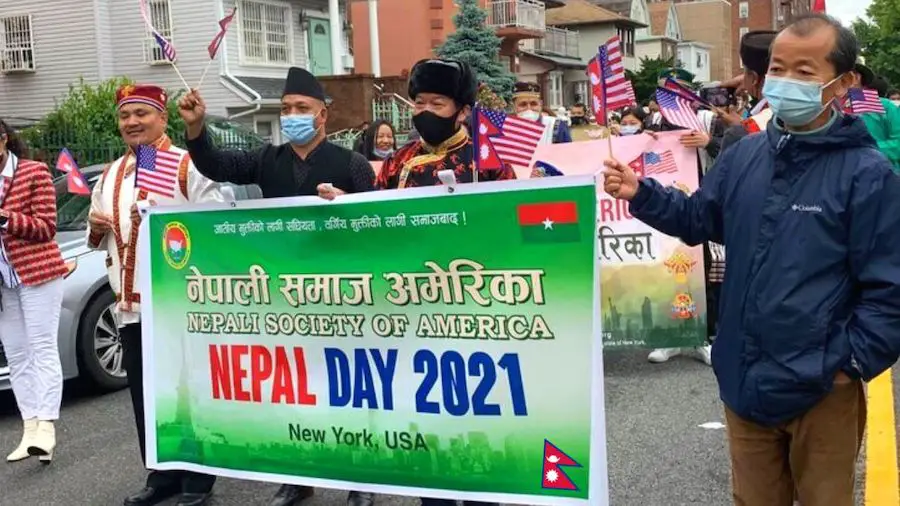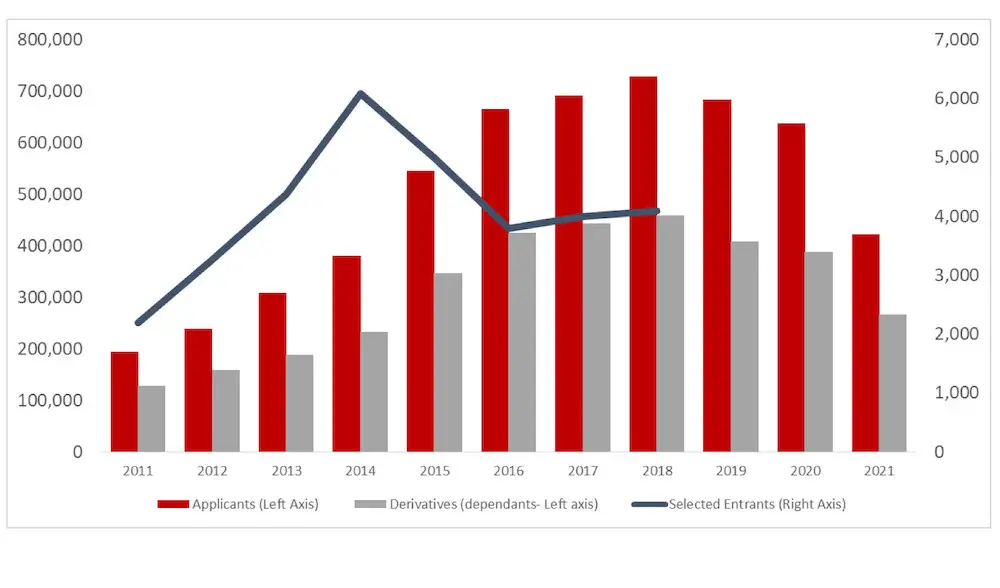When it comes to diversity and immigration in the USA, many of my friends in Nepal and the USA want to know just how many Nepalese are in the USA.
Well, migration from Nepal to the USA is a relatively recent phenomenon. The number of Nepalis in the USA has steadily increased since the 1990s. Nepalese immigrants have come to the USA for various reasons, including education, work, and resettlement.
In this blog, we will explore the history of Nepalese migration to the USA, the number of Nepalese on various types of visas, the latest research on immigration to the USA, the number of Bhutanese Nepalese in the country, and where the largest communities of Nepalis are residing in the USA.
History of Nepalese in the USA:
Nepali Americans have been immigrating to the United States since the early 1900s. Initially, they were classified as “other Asian” immigrants. It wasn’t until 1974 when 56 Nepalese individuals had migrated to the US, that Nepalese Americans were recognized as a distinct ethnic group. The number of immigrants from Nepal remained under 100 per year until 1992.

As per the 1990 US Census, there were 2,616 Americans of Nepalese descent. Although fewer than 100 Nepalese immigrants naturalized as US citizens each year, the number of Nepalese obtaining legal residency steadily increased. It rose from 78 in 1987 to 431 in 1996. The Nepalese community experienced significant population growth in the 2000s. This was due to the poor political and economic conditions which resulted from the Nepalese Civil War. This prompted increased emigration from Nepal.
Today, Nepali-American communities reside in significant numbers in major metropolitan areas. These areas include Texas, New York City, Boston, Chicago, Denver, Gainesville, Florida, Portland, and Saint Paul, Minnesota. Over time, Nepalis have integrated themselves into mainstream politics. Harry Bhandari was the first Nepalese American elected to public office after winning a State Delegate race in Maryland in 2018.
Who was the first person to visit the US from Nepal?
In 1939, General Krishna Rana, Nepal’s Minister in London, made the first official Nepalese visit to the United States. This was followed by a visit from his successor, General Shinga Rana, in 1945. In the summer of 1946, Commanding General Baber Rana led a Nepalese mission to the United States, where the State and War Departments, for several weeks, hosted them. Their visit to Washington, DC, took place from July 25 to August 1 of that year.
How many Nepalis are in the USA?
According to the American Community Survey (ACS), there were approximately 208,000 Nepalese in the USA in 2020. This number has increased significantly since 2010, when there were around 59,000 Nepalese in the country.
| Year | Population |
|---|---|
| 2000 | 9,000 |
| 2010 | 59,000 |
| 2015 | 140,000 |
| 2019 | 198,000 |
The Migration Policy Institute reports that approximately 97% of Nepalese in the USA are foreign-born, and 62 percent of them are naturalized citizens. The median household income of Nepalese in the USA is $70,000, which is higher than the median income of all immigrant households in the USA.
Breakdown of Nepali Population in US by State:
Texas has the most Nepalis living in it at 21,764, followed by New York with 16,699 and California with 14,040.
The table below shows the number of Nepalese people in each state in the USA. Additionally, it shows the percentage change from 2015 to 2020.
| State | 2015 | 2020 | Change (%) |
|---|---|---|---|
| Alabama | 424 | 703 | 65.80% |
| Alaska | 158 | 289 | 82.91% |
| Arizona | 1,354 | 1,760 | 29.99% |
| Arkansas | 83 | 357 | 330.12% |
| California | 9,611 | 14,040 | 46.08% |
| Colorado | 4,135 | 4,679 | 13.16% |
| Connecticut | 1,118 | 1,235 | 10.47% |
| Delaware | 348 | 44 | -87.36% |
| District of Columbia | 213 | 449 | 110.80% |
| Florida | 1,178 | 1,518 | 28.86% |
| Georgia | 3,020 | 4,212 | 39.47% |
| Hawaii | 218 | 326 | 49.54% |
| Idaho | 512 | 1,290 | 151.95% |
| Illinois | 2,414 | 3,636 | 50.62% |
| Indiana | 535 | 737 | 37.76% |
| Iowa | 686 | 2,268 | 230.61% |
| Kansas | 876 | 1,884 | 115.07% |
| Kentucky | 1,403 | 3,356 | 139.20% |
| Louisiana | 442 | 809 | 83.03% |
| Maine | 15 | 150 | 900.00% |
| Maryland | 5,731 | 8,894 | 55.19% |
| Massachusetts | 5,601 | 5,867 | 4.75% |
| Michigan | 1,831 | 2,637 | 44.02% |
| Minnesota | 1,564 | 2,970 | 89.90% |
| Mississippi | 211 | 475 | 125.12% |
| Missouri | 1,137 | 2,000 | 75.90% |
| Montana | 137 | 84 | -38.69% |
| Nebraska | 1,312 | 2,169 | 65.32% |
| Nevada | 504 | 985 | 95.44% |
| New Hampshire | 1,613 | 2,420 | 50.03% |
| New Jersey | 1,504 | 1,891 | 25.73% |
| New Mexico | 231 | 598 | 158.87% |
| New York | 10,168 | 16,699 | 64.23% |
| North Carolina | 3,769 | 5,863 | 55.56% |
| North Dakota | 636 | 1,319 | 107.39% |
| Ohio | 4,198 | 12,995 | 209.55% |
| Oklahoma | 654 | 791 | 20.95% |
| Oregon | 1,124 | 572 | -49.11% |
| Pennsylvania | 4,656 | 9,674 | 107.77% |
| Puerto Rico | 26 | 0 | -100.00% |
| Rhode Island | 456 | 70 | -84.65% |
| South Carolina | 126 | 167 | 32.54% |
| South Dakota | 286 | 777 | 171.68% |
| Tennessee | 1,574 | 1,791 | 13.79% |
| Texas | 12,190 | 21,764 | 78.54% |
| Utah | 1,721 | 1,740 | 1.10% |
| Vermont | 690 | 1,187 | 72.03% |
| Virginia | 7,499 | 8,167 | 8.91% |
| Washington | 2,444 | 3,217 | 31.63% |
| West Virginia | 150 | 358 | 138.67% |
| Wisconsin | 1,010 | 1,080 | 6.93% |
| Wyoming | 56 | 30 | -46.43% |
How many Nepalis are on a Diversity Visa?
The Diversity Immigrant Visa Lottery, commonly known as the DV Lottery, is a program offered by the United States that randomly selects immigrants from across the globe to receive a green card and enter the country. The program also provides an opportunity for individuals and families from Nepal to have a chance to immigrate to the US.
Every year, over 600,000 Nepalese individuals apply, and in 2018, the program granted permanent residency in the US to 4,097 of them. Additionally, in the previous year, 7,409 Nepalis obtained US citizenship, while 10,201 were granted permanent residence. Texas, New York, California, Virginia, and Ohio are the top five states with the largest population of Nepalis.
The image below shows the number of DV visa applications and the number of participants selected to go to the US.

How many Nepalis are on a Student visa in the USA?
There are 11,779 Nepali students studying in the USA as of 2021/2022. Nepal is now ranked as the 12th leading country of origin for international students coming to the United States.
The Institute of International Education (IIE) and the US Department of State Bureau of Educational and Cultural Affairs have released the 2021/2022 Open Doors Report on International Educational Exchange, which indicates a 5.6 percent increase in the number of Nepali students studying in the United States, totaling 11,779.
The report also shows that new international student enrollment rebounded in 2021/2022, increasing by 80 percent, leading to a four percent overall increase in the total number of international students enrolled in US institutions.
Where are the largest Nepalese communities living in the USA?
The largest Nepalese communities in the USA are located in the New York City metropolitan area, followed by the Washington DC metropolitan area, the Boston metropolitan area, and the Los Angeles metropolitan area.
How many Bhutanese Nepalese live in the USA?
Individuals of Nepali descent who were forced out of Bhutan and temporarily settled in refugee camps located in the eastern regions of Nepal are the Bhutanese refugees. From 2008 onwards, various parts of the world, including the US, have relocated many of these refugees, with 96,581 Bhutanese refugees currently residing in the US alone.
Most Bhutanese refugees who came to the US as political refugees from Nepal officially registered as Nepalese Americans, which often results in an underreporting of the actual number of Bhutanese Americans.
Key Takeaways: Nepalis in the USA
In conclusion, the Nepalese community in the USA has been steadily growing over the past few decades. Most Nepalese immigrants have come to the USA for education or work opportunities, and many have been naturalized citizens. Nepalese immigrants have settled in various parts of the USA, with the largest communities located in the New York City metropolitan area, the Washington DC metropolitan area, the Boston metropolitan area, and the Los Angeles metropolitan area.
In recent years, there has also been an increase in the number of Bhutanese Nepalese people resettling in the USA. As of 2020, there were approximately 208,000 Nepalese in the USA, with around 16,000 Nepalese students studying there. The median household income of Nepalese in the USA is higher than the median income of all immigrant households in the USA.
Overall, the Nepalese community in the US is a diverse and growing population. Their contributions to American society in various fields, including education, business, and healthcare, are significant and noteworthy. As the Nepalese community continues to grow and thrive in the USA, it is important to recognize and celebrate their achievements and contributions to American society.
FAQs: How many Nepalis are in the US?
Below are the most frequently asked questions regarding how many Nepali people live in America.
Texas has the most Nepalis living in it at 21,764, followed by New York with 16,699, and California with 14,040 as of 2022.
Most Nepalese students study at one of the four following universities: East Central University in Oklahoma, McNeese State University in Louisiana, University of Louisiana at Monroe in Louisiana, and Central Oklahoma University in Oklahoma.
The top 10 universities that Nepalese study at are:
1. East Central University
2. McNeese State University
3. University of Louisiana at Monroe
4. Central Oklahoma University
5. Morehead State University
6. Minnesota State University, Mankato
7. University of South Florida
8. Mississippi University for Women
9. Northwestern Oklahoma State University
10. Southeast Louisiana State University
Most Nepalese people in the USA live in New York City, Washington DC, Texas, California, Virginia, Maryland, Massachusetts, and Colorado.

I’m still surprised how Nepalese Americans have more median household wealth than Indians and China.
I was surprised as well! I will have to do some more research and see if it has changed recently or not… Maybe it has to do with the smaller population of Nepalis compared to Indians and Chinese.